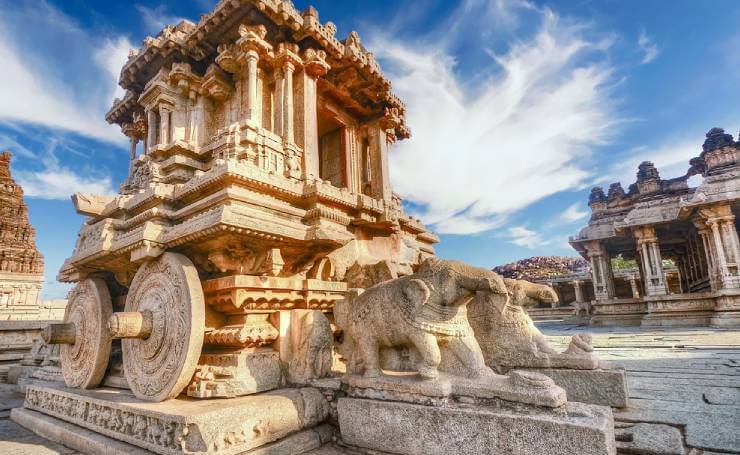
India, a land of diversity and spirituality, is home to a myriad of religious destinations that hold profound cultural and historical significance. From ancient temples to revered mosques, the spiritual landscape of India is a tapestry woven with threads of devotion and centuries-old traditions. In this blog, we embark on a divine odyssey, exploring some of the most significant religious places in India that have not only stood the test of time but continue to be beacons of spiritual enlightenment.
I. Varanasi – The Spiritual Heartbeat of India:
Nestled on the banks of the sacred Ganges River, Varanasi, also known as Kashi, is one of the oldest continuously inhabited cities in the world. It is a melting pot of spirituality, culture, and tradition. The Ghats of Varanasi, including the Dashashwamedh Ghat and Manikarnika Ghat, are iconic pilgrimage sites where Hindus gather to perform rituals, cremate their deceased, and seek spiritual solace.
Kashi Vishwanath Temple: At the heart of Varanasi stands the Kashi Vishwanath Temple, dedicated to Lord Shiva. It is one of the holiest shrines for Hindus, attracting devotees from around the globe. The temple’s golden spire and sanctum sanctorum resonate with the divine energy that permeates the city.
II. Golden Temple, Amritsar – A Sikh Sanctuary:
Amritsar, in the state of Punjab, is home to the iconic Golden Temple, the spiritual and cultural epicenter of Sikhism. The temple, also known as Harmandir Sahib, is a marvel of architectural beauty, with its golden façade surrounded by the sacred Amrit Sarovar (Pool of Nectar).
Langar at Golden Temple: A unique aspect of the Golden Temple is the Langar, a community kitchen that serves free meals to all visitors, regardless of their background. This symbolizes the Sikh principles of equality, selfless service, and communal harmony.
III. Ajmer Sharif Dargah – Sufi Mysticism in Rajasthan:
Nestled in the heart of Rajasthan, Ajmer is home to the revered Ajmer Sharif Dargah, the final resting place of the Sufi saint Khwaja Moinuddin Chishti. The Dargah is a testament to the syncretic culture of India, where people of all faiths come to seek the saint’s blessings.
Urs Festival: The annual Urs festival at Ajmer Sharif is a vibrant celebration, attracting devotees from different religious backgrounds. It commemorates the death anniversary of Khwaja Moinuddin Chishti and is marked by spiritual gatherings, qawwalis, and a sense of unity among followers.
IV. Bodh Gaya – The Enlightenment of Lord Buddha:
Bodh Gaya, located in the state of Bihar, holds immense significance in Buddhism as the place where Siddhartha Gautama attained enlightenment under the Bodhi Tree. The Mahabodhi Temple, a UNESCO World Heritage Site, stands as a symbol of Buddhist pilgrimage and enlightenment.
Bodhi Tree: The sacred Bodhi Tree, believed to be a descendant of the original tree under which Buddha meditated, is a focal point for meditation and reflection. Pilgrims from around the world visit Bodh Gaya to connect with the spiritual legacy of Lord Buddha.
V. Kedarnath – Abode of Lord Shiva in the Himalayas:
Nestled amidst the breathtaking Himalayan peaks, Kedarnath is one of the holiest shrines dedicated to Lord Shiva. The Kedarnath Temple, situated at an altitude of over 11,000 feet, is part of the Char Dham Yatra and holds a special place in Hindu mythology.
Panch Kedar: Kedarnath is one of the Panch Kedar, a group of five sacred shrines dedicated to Lord Shiva in the Garhwal region. Pilgrims undertake arduous journeys to seek the divine blessings of Lord Shiva in this pristine and awe-inspiring Himalayan setting.
VI. Jama Masjid, Delhi – Architectural Grandeur of Islam:
Delhi, the capital city of India, is adorned with the grandeur of Jama Masjid, one of the largest mosques in the country. Built by Emperor Shah Jahan, the mosque showcases magnificent Mughal architecture and stands as a testament to India’s rich Islamic heritage.
Chandni Chowk: Adjacent to Jama Masjid is the bustling market of Chandni Chowk, offering a vibrant tapestry of colors, sounds, and flavors. The area is a microcosm of Delhi’s diverse cultural and religious influences.
VII. Tirupati Balaji – Wealth of Devotion in Andhra Pradesh:
Tirupati, located in the state of Andhra Pradesh, is synonymous with the revered temple of Lord Venkateswara, also known as Tirupati Balaji. The temple, perched on the Tirumala Hills, attracts millions of devotees annually.
Laddu Prasadam: A unique tradition at Tirupati is the distribution of the famous Laddu Prasadam. Pilgrims consider it auspicious to receive this sweet offering, believed to carry the blessings of Lord Venkateswara.
VIII. Rishikesh and Haridwar – The Spiritual Gateway to the Himalayas:
The twin towns of Rishikesh and Haridwar, situated along the banks of the Ganges River in Uttarakhand, are revered as spiritual gateways to the Himalayas. These towns are hubs of pilgrimage, yoga, and spiritual retreats.
Ganga Aarti: The Ganga Aarti performed on the ghats of Haridwar is a mesmerizing spectacle that draws pilgrims and tourists alike. The rhythmic chants, flickering lamps, and the sacred river create an ambiance of spiritual transcendence.
IX. Velankanni – Basilica of Our Lady of Good Health:
Located on the shores of the Bay of Bengal in Tamil Nadu, Velankanni is home to the Basilica of Our Lady of Good Health. This revered Christian pilgrimage site attracts devotees seeking solace, healing, and divine intervention.
Annual Feast of Our Lady of Good Health: The annual feast in September, dedicated to Our Lady of Good Health, witnesses a massive gathering of devotees. The Basilica is a symbol of faith and miracles for Christians across India.
X. Hemkund Sahib – Sikh Pilgrimage in the Himalayas:
Hemkund Sahib, situated in the Garhwal region of Uttarakhand, is a high-altitude Sikh pilgrimage site. Surrounded by snow-capped peaks and pristine glacial lakes, it is a place of spiritual significance for Sikhs.
The Sikh Guru Connection: Hemkund Sahib is associated with Guru Gobind Singh, the tenth Sikh Guru. The serene Hemkund Lake is believed to be the place where Guru Gobind Singh meditated in a previous life.
Conclusion:
India’s spiritual mosaic is woven with threads of devotion, diversity, and a rich tapestry of religious heritage. The significant religious places mentioned here are not just architectural marvels but living embodiments of the spiritual fervor that has resonated through the ages. Pilgrims and seekers from every corner of the globe continue to embark on journeys to these sacred sites, seeking solace, enlightenment, and a connection with the divine in the diverse and mystical landscape of India.



